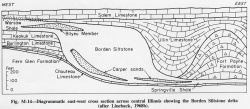Springville Shale
Lithostratigraphy: Mammoth Cave Limestone Megagroup >>Springville Shale
Chronostratigraphy: Paleozoic Erathem >>Mississippian Subsystem >>Valmeyeran Series
Allostratigraphy: Kaskaskia Sequence
Primary source
Willman, H. B., Elwood Atherton, T. C. Buschbach, Charles Collinson, John C. Frye, M. E. Hopkins, Jerry A. Lineback, and Jack A. Simon, 1975, Handbook of Illinois Stratigraphy: Illinois State Geological Survey Bulletin 95, 261 p.
Contributing author(s)
Elwood Atherton, Charles Collinson, and Jerry A. Lineback
Name
Original description
Springville Shale (Savage, 1920, p. 169-178; Collinson and Scott, 1958a, p. 11).
Derivation
Named for the now abandoned village of Springville, Union County, which was located a short distance southeast of the type exposures.
Other names
History/background
Type section
Type location
The type exposures of the Springville Shale are in the bed and banks of a creek 4 miles southeast of Anna (SE 3, 13S-1W).
Type author(s)
Type status
Reference section
Reference location
Reference author(s)
Reference status
Stratigraphic relationships
The Springville Shale is the basal member of the Valmeyeran Series in southern Illinois. The shale is the deep-water equivalent of the Borden delta, and it is separated from the Borden Siltstone by vertical cut-off where the Borden thins to 100 feet (Lineback, 1966) (fig. M-14). The Springville overlies the Chouteau Limestone or, where the Chouteau is absent, the New Albany Group. It is overlain by the Fort Payne Formation or the Ullin Limestone.
Extent and thickness
The Springville Shale crops out discontinuously northward from the type exposures to Jonesboro, in a fault slice along the Shawneetown Fault in Saline County, and on the flanks of Hicks Dome in Hardin County. The Springville is as much as 100 feet thick, but in most of southern Illinois it is less than 50 feet thick, and in some places it is absent.
Lithology
Savage included in the Springville the thin Chouteau Limestone and the shale in the upper part of the New Albany Group, but these were removed by Collinson and Scott (1958a). The formation consists of greenish gray to dark brownish gray, clayey shale. A bed of soft glauconitic shale at the base is differentiated as the State Pond Member. In places, the Springville is mottled red and green and has been informally called the "calico shale." Lenses of the "Carper sand" are present in the areas of thicker shale.
Core(s)
Photograph(s)
Contacts
Well log characteristics
Fossils
Age and correlation
Environments of deposition
Economic importance
Remarks
References
COLLINSON, CHARLES, and A. J. SCOTT, 1958a, Age of the Springville Shale (Mississippian) of southern Illinois: Illinois State Geological Survey Circular 254, 12 p.
LINEBACK, J. A., 1966, Deep-water sediments adjacent to the Borden Siltstone (Mississippian) delta in southern Illinois: Illinois State Geological Survey Circular 401, 48 p.
SAVAGE, T. E., 1920, Devonian formations of Illinois: American Journal of Science, v. 49, p. 169-182.
ISGS Codes
| Stratigraphic Code | Geo Unit Designation |
|---|---|
